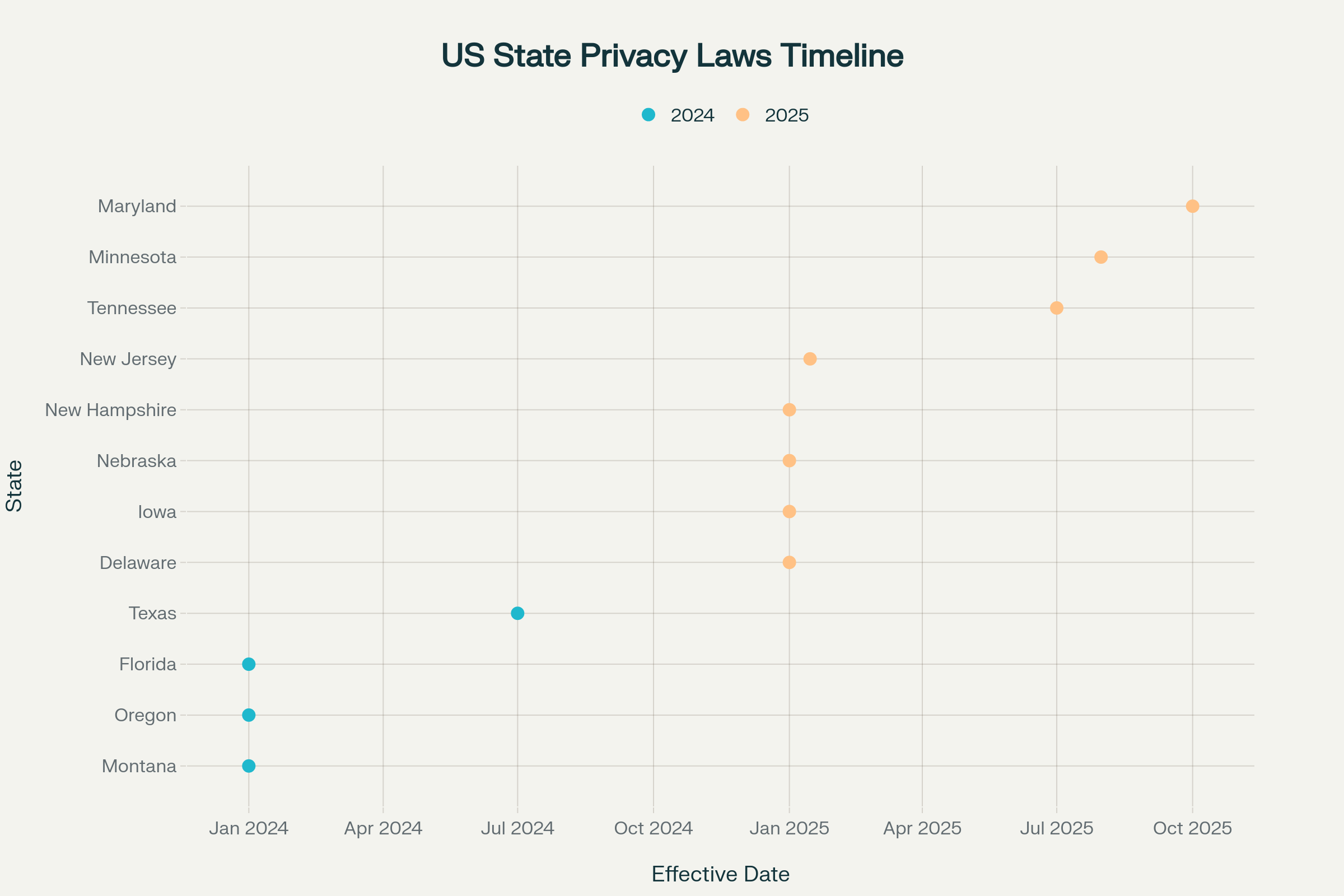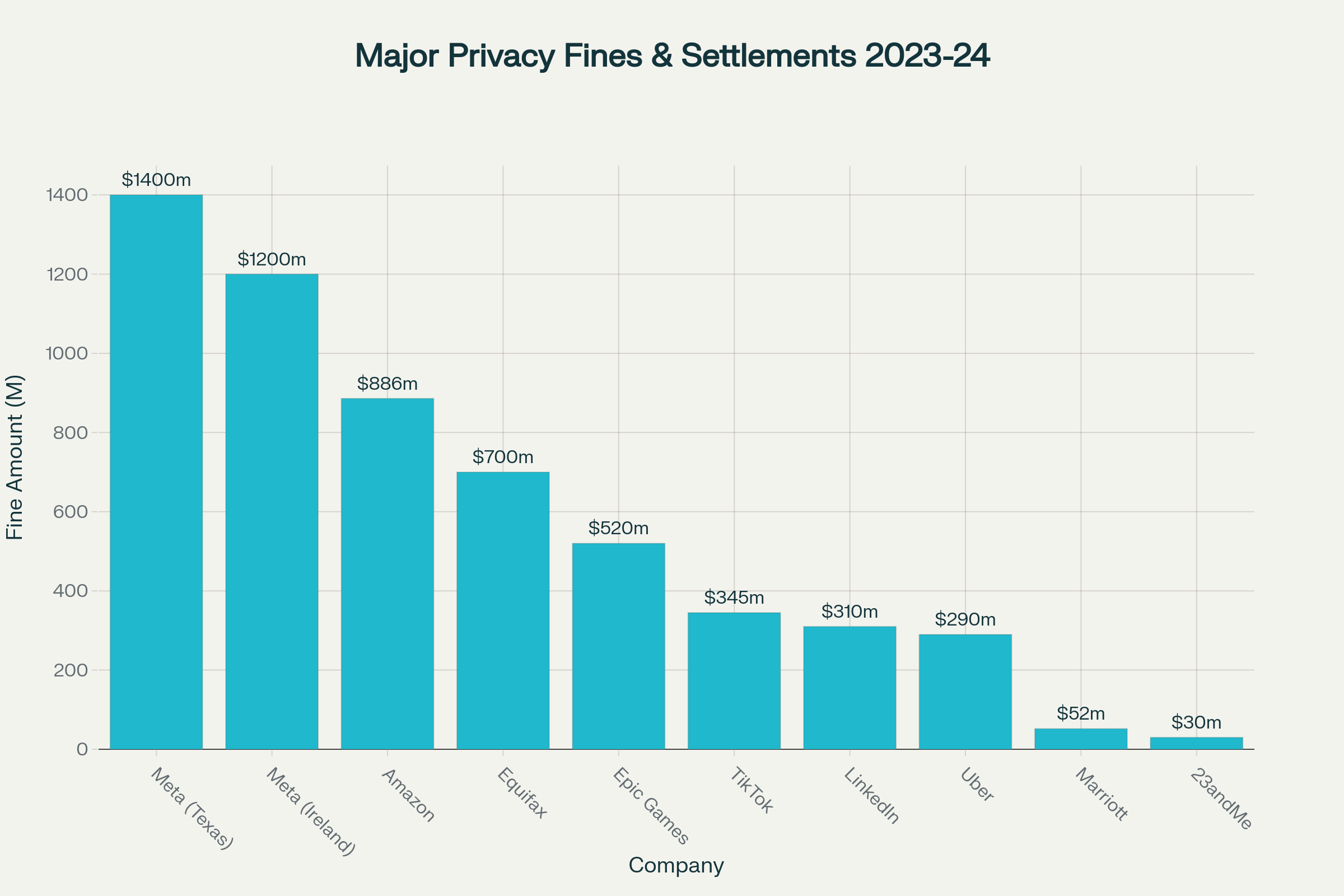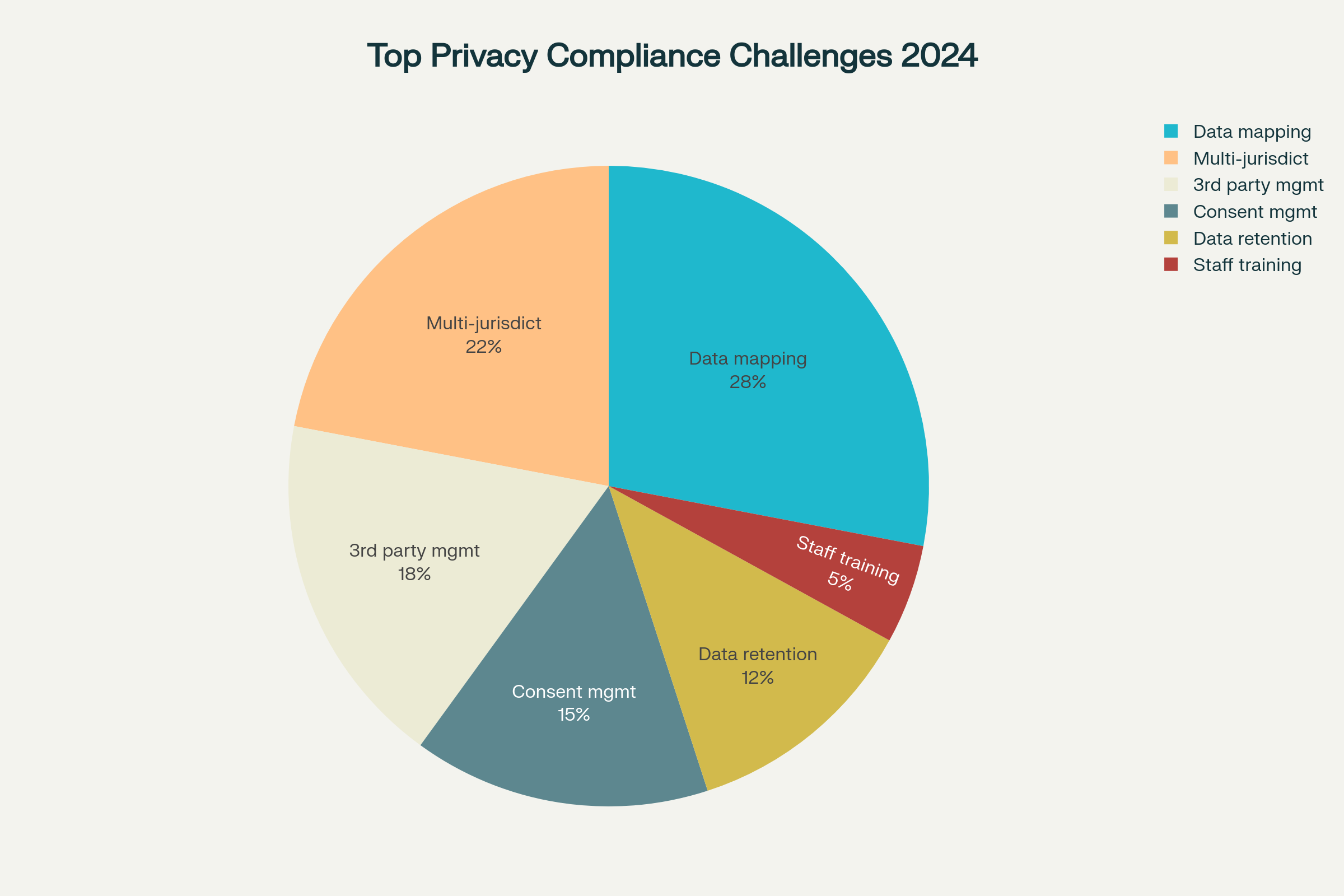The privacy landscape has undergone seismic shifts since the original publication of this guide. What was once a “messy world” of US privacy laws has become an even more complex patchwork system, with eight new state privacy laws taking effect in 2024-2025 and unprecedented enforcement actions reaching into the billions of dollars.
The stakes have never been higher. As Joe Paranteau, a seasoned veteran in both technology and sales, understands well: the intersection of asymmetric thinking and compliance isn’t just about avoiding penalties—it’s about turning regulatory challenges into competitive advantages. For businesses, government agencies, and individuals alike, understanding these evolving requirements isn’t optional; it’s essential for survival in the digital economy.
The Accelerating State-Level Privacy Revolution
The 2024-2025 Wave of New Laws
The state-level privacy revolution has reached unprecedented momentum. Twenty states now have comprehensive privacy laws on the books, with fourteen currently in effect and more coming online throughout 2025. This expansion represents the largest single-year increase in state privacy legislation to date.

Timeline of new US state privacy laws becoming effective from 2024-2025, showing the rapid expansion of state-level privacy legislation
The timeline reveals a clear pattern: states are no longer waiting for federal action. Delaware, Iowa, Nebraska, and New Hampshire all enacted laws effective January 1, 2025, followed by New Jersey on January 15, 2025. Tennessee, Minnesota, and Maryland round out the year with laws taking effect in summer and fall 2025.
What Makes These Laws Different
Unlike earlier privacy laws that closely mirrored California’s CCPA, the 2024-2025 generation of state laws introduces unique variations that create new compliance challenges:
- Nebraska’s broad scope: Unlike most state privacy laws, Nebraska applies to all companies operating in the state, regardless of data volume or revenue thresholds
- Tennessee’s revenue requirement: Adds a $25 million annual revenue threshold alongside traditional data processing thresholds
- Maryland’s stricter data minimization: Implements some of the most stringent data minimization standards seen in US privacy law
- New Jersey’s profiling protections: Allows consumers to opt out of profiling through preference signals, a unique feature among state laws
The Compliance Multiplication Effect
For businesses operating across multiple states, the compliance burden has become exponentially more complex. A company serving customers in California, Virginia, Colorado, and the eight new 2025 states must now navigate eleven different sets of privacy requirements, each with its own nuances regarding:
- Consumer rights and request procedures
- Data processing lawfulness requirements
- Breach notification timelines
- Consent management standards
- Third-party data sharing restrictions
The Billion-Dollar Cost of Non-Compliance
Record-Breaking Penalties Shape the Landscape
The financial consequences of privacy non-compliance have reached unprecedented levels, with 2024 seeing over $1 billion in total privacy fines and settlements. These penalties are no longer just regulatory slaps on the wrist—they represent existential threats to business operations.

Major privacy fines and settlements from 2023-2024, showing the increasing financial penalties for non-compliance with data protection laws
The chart above illustrates the staggering scale of recent penalties, led by Meta’s $1.4 billion settlement with Texas for biometric data violations—the largest privacy settlement in US history. This case exemplifies how state attorneys general are increasingly wielding privacy laws as enforcement tools, with Texas filing its first privacy law enforcement action in January 2025 against Allstate and its subsidiaries.
Case Study: The Meta Biometric Data Scandal
Meta’s Texas settlement provides a sobering lesson in the hidden costs of privacy non-compliance. The company allegedly:
- Collected biometric data from millions of Texans without proper consent
- Used facial recognition technology on photos without notification
- Violated Texas’s Biometric Information Privacy Act repeatedly over several years
The $1.4 billion penalty represents approximately 2.3% of Meta’s 2023 revenue—a significant but not crippling amount for a tech giant. However, for smaller companies, similar violations could prove fatal.
The Ripple Effects Beyond Fines
The true cost of non-compliance extends far beyond monetary penalties:
Reputational Damage: 87% of consumers will take their business elsewhere if they don’t trust a company’s data handling practices. The long-term revenue impact often exceeds the immediate fine.
Operational Disruption: Companies facing privacy violations must often:
- Halt data processing operations
- Implement costly remediation measures
- Undergo extended regulatory oversight
- Rebuild technical infrastructure
Legal Precedent: High-profile cases create legal precedents that make future enforcement actions more likely and more severe.
Current Compliance Challenges: What Businesses Are Struggling With
The Data Mapping Crisis
Research reveals that data mapping and discovery represents the single biggest compliance challenge for businesses in 2024, affecting 28% of organizations. This isn’t surprising given the complexity of modern data ecosystems.

The most significant privacy compliance challenges businesses face in 2024, with data mapping and discovery being the top concern
The challenge stems from the third-party dilemma: modern websites typically contain 200-300 different dependencies, each potentially collecting and sharing user data. Organizations often discover they have little visibility into:
- What personal data third-party tools are collecting
- Where that data is being processed or stored
- Who has access to the data
- How long the data is being retained
Multi-Jurisdictional Compliance Complexity
Multi-jurisdictional compliance ranks as the second-biggest challenge at 22%. This challenge has intensified dramatically with the 2024-2025 wave of new state laws. Companies must now navigate:
- Nineteen different US state privacy laws with varying requirements
- GDPR compliance for any EU customer interactions
- Sector-specific regulations like HIPAA, GLBA, and COPPA
- International frameworks in countries where they operate
The Vendor Management Nightmare
Third-party vendor management represents 18% of compliance challenges, and this percentage is likely to grow. The recent Allstate enforcement action demonstrates how companies can be held liable for their vendors’ data collection practices.
In that case, Allstate’s subsidiaries developed software development kits (SDKs) that were integrated into third-party mobile applications. The SDKs collected location data from over 45 million Americans without proper consent, leading to Texas’s first privacy law enforcement action.
Commercial vs. Public Sector: Different Challenges, Similar Stakes
Commercial Sector Impacts
The commercial sector faces unique challenges driven by competitive pressures and profit motives:
Revenue-Driven Data Collection: Companies rely on personal data for targeted advertising, personalization, and business intelligence. Privacy compliance often conflicts with revenue-generating activities.
Resource Constraints: Smaller and medium-sized businesses struggle with the cost of compliance infrastructure. Implementing comprehensive privacy programs can require significant investment in:
Innovation vs. Compliance Tension: The push for AI and machine learning innovations often conflicts with privacy requirements. Companies must balance competitive advantage with regulatory compliance.
Public Sector Unique Challenges
Government agencies face distinct privacy challenges that private companies don’t encounter:
Transparency vs. Privacy: Public sector organizations must balance open government requirements with individual privacy protection. This creates unique tensions around data sharing and public records access.
Legacy System Integration: Many government agencies operate outdated IT systems that weren’t designed with privacy in mind. Modernizing these systems while maintaining security and compliance is extraordinarily complex.
Limited Resources: Unlike private companies, government agencies can’t easily increase budgets for privacy compliance. They must often accomplish more with the same or fewer resources.
Data Sharing Complexity: Government agencies must share data across departments and with other agencies while maintaining privacy protections. This creates complex interagency coordination challenges.
Case Study: Federal Agency Privacy Failures
Recent reports reveal that many federal agencies still fail to meet basic privacy requirements established in 2018. The National Institute of Standards and Technology published a framework for incorporating privacy into risk management strategies, but:
- The State Department, NASA, and HUD are still working to meet basic privacy recommendations
- The Department of Interior and Justice Department have unclear compliance status
- Fourteen agencies failed to incorporate privacy into their risk management strategies according to a Government Accountability Office report
This failure to implement basic privacy frameworks leaves the federal government ill-prepared to handle growing data responsibilities, especially as agencies embrace AI and digital transformation initiatives.
What’s Actually Required for Compliance: Beyond the Basics
The Privacy by Design Imperative
Modern privacy compliance requires privacy by design principles, not just reactive compliance measures. This means:
Proactive Integration: Privacy considerations must be built into systems, processes, and business practices from the ground up, not added as an afterthought.
Default Privacy Settings: Systems should be designed with maximum privacy protection as the default, requiring users to opt into less private options rather than opting out.
Continuous Assessment: Organizations must conduct regular Privacy Impact Assessments (PIAs) to identify and mitigate privacy risks before they become violations.
Data Protection Officer Requirements
Under various privacy laws, many organizations must appoint Data Protection Officers (DPOs) with specific qualifications and responsibilities:
Required Expertise: DPOs must have:
- Deep knowledge of privacy laws across all relevant jurisdictions
- Technical understanding of data processing systems
- Ability to conduct privacy risk assessments
- Management skills to coordinate across business units
Independence Requirements: DPOs must be able to:
- Report directly to senior management
- Operate without conflicts of interest
- Access all personal data processing operations
- Maintain confidentiality while performing duties
Ongoing Responsibilities: DPOs must:
- Monitor compliance across the organization
- Serve as the primary contact with regulatory authorities
- Conduct regular privacy audits and assessments
- Provide privacy training to staff
The Consent Management Revolution
Consent management has evolved from simple cookie banners to sophisticated multi-channel preference orchestration. Modern consent management requires:
Cross-Platform Synchronization: User preferences must be synchronized across:
- Websites and mobile applications
- Email marketing systems
- Third-party advertising platforms
- Customer relationship management systems
Granular Control: Users must be able to:
- Specify different preferences for different data uses
- Withdraw consent as easily as they provided it
- Access their complete consent history
- Modify preferences at any time
Regulatory Compliance: Consent systems must meet the requirements of:
- GDPR’s explicit consent standards
- CCPA’s opt-out rights
- State-specific privacy law requirements
- Google’s new consent mode requirements
Tools and Technologies: The Compliance Infrastructure
The Privacy Technology Stack
Modern privacy compliance requires a comprehensive technology stack that addresses different aspects of data protection:
Data Discovery and Classification: Tools like Varonis and Cyera use AI to automatically discover and classify sensitive data across cloud and on-premises environments.
Consent Management Platforms: Solutions like Osano, OneTrust, and Cookiebot provide comprehensive consent management across multiple channels.
Data Security Platforms: Rubrik and Dell offer data protection solutions that secure data both at rest and in transit.
Privacy Management Suites: Comprehensive platforms like TrustArc and Enzuzo provide end-to-end privacy program management.
The $500,000 Guarantee Revolution
Some privacy technology vendors now offer “No Fines, No Penalties” guarantees of up to $500,000, demonstrating their confidence in their compliance solutions. This represents a significant shift in the privacy technology market, where vendors are willing to share financial risk with their customers.
Emerging Privacy-Enhancing Technologies
Privacy-Enhancing Computation (PEC) technologies are becoming essential for organizations that need to process sensitive data while maintaining privacy protections:
- Homomorphic encryption allows computation on encrypted data
- Secure multiparty computation enables collaborative analysis without data sharing
- Federated learning allows AI model training without centralizing data
The Road Ahead: Predictions and Preparation
2025 Enforcement Trends
Based on current patterns, expect intensified enforcement in several areas:
State Attorney General Actions: Following Texas’s lead, expect more state AGs to file privacy enforcement actions, particularly targeting:
- Biometric data collection without consent
- Third-party data sharing without disclosure
- AI-powered profiling without user control
Federal Trade Commission Focus: The FTC will likely continue targeting:
International Coordination: Expect increased coordination between US and international privacy authorities, particularly regarding:
- Cross-border data transfers
- Global technology company enforcement
- Harmonization of privacy standards
Technology Evolution
AI and Privacy Convergence: The integration of AI into privacy compliance tools will accelerate, providing:
Privacy-First Architecture: Organizations will increasingly adopt privacy-first system architectures that make compliance easier and more cost-effective.
Conclusion: From Compliance Burden to Strategic Advantage
The privacy landscape of 2025 is fundamentally different from even two years ago. What was once a primarily European concern has become a global business imperative, with twenty US states now having comprehensive privacy laws and over $1 billion in penalties demonstrating the financial stakes involved.
For leaders like Joe Paranteau, who understand the power of asymmetric thinking, this regulatory complexity represents an opportunity rather than just a burden. Organizations that master privacy compliance early gain several strategic advantages:
Consumer Trust: In an era where 72% of consumers will stop buying from companies after data breaches, privacy compliance becomes a competitive differentiator.
Operational Efficiency: Companies that implement privacy by design principles often find their data operations become more efficient and secure overall.
Innovation Enablement: Strong privacy foundations enable safer experimentation with AI and other data-driven technologies.
Risk Mitigation: Proactive privacy compliance protects against the exponentially growing financial and reputational risks of violations.
The privacy maze isn’t getting simpler—it’s getting more complex every year. But for organizations that invest in understanding and mastering these requirements, the regulatory complexity becomes a moat that protects them from less prepared competitors.
The choice is clear: organizations can either react to privacy requirements as burdens to be minimized, or they can proactively embrace privacy as a strategic advantage. In 2025 and beyond, this choice will likely determine which organizations thrive and which merely survive in the evolving digital economy.
Remember: In the world of privacy compliance, asymmetric thinking isn’t just helpful—it’s essential. The organizations that see privacy regulations not as obstacles but as opportunities to build stronger, more trustworthy businesses will be the ones that succeed in the long run.

